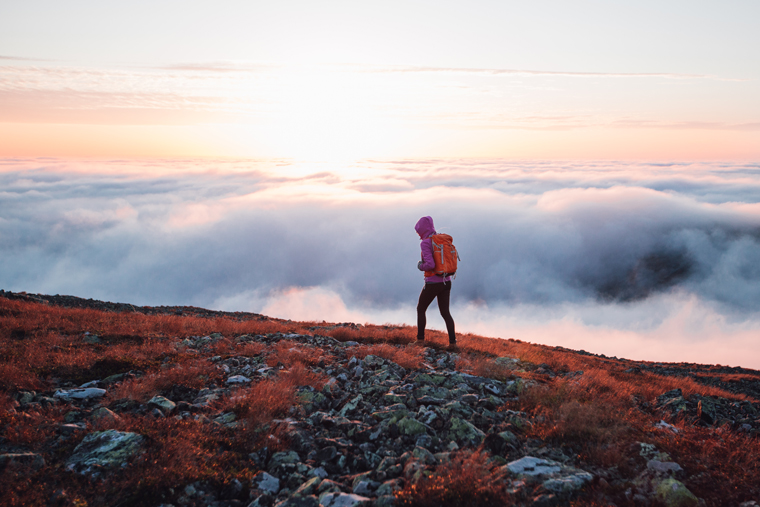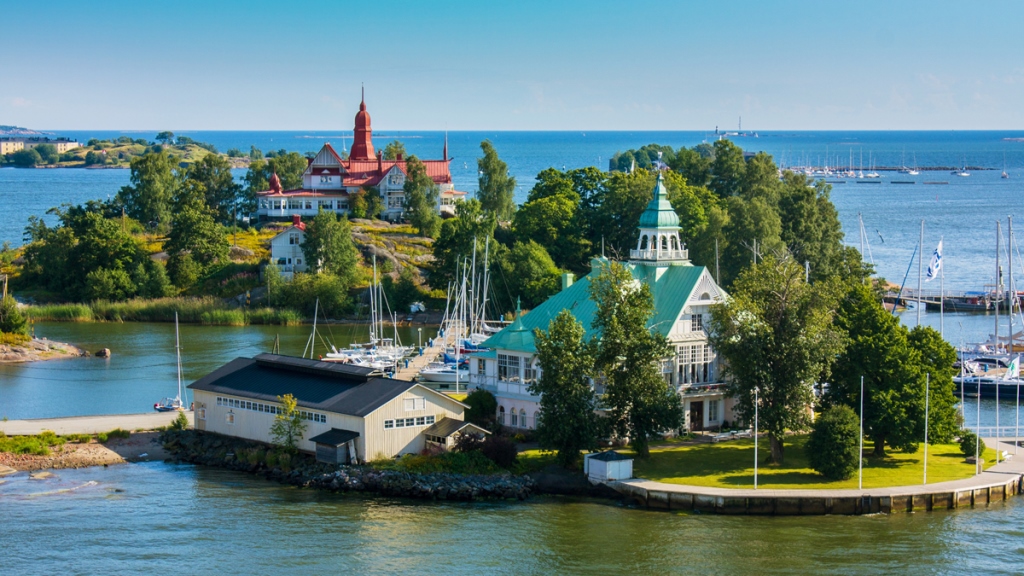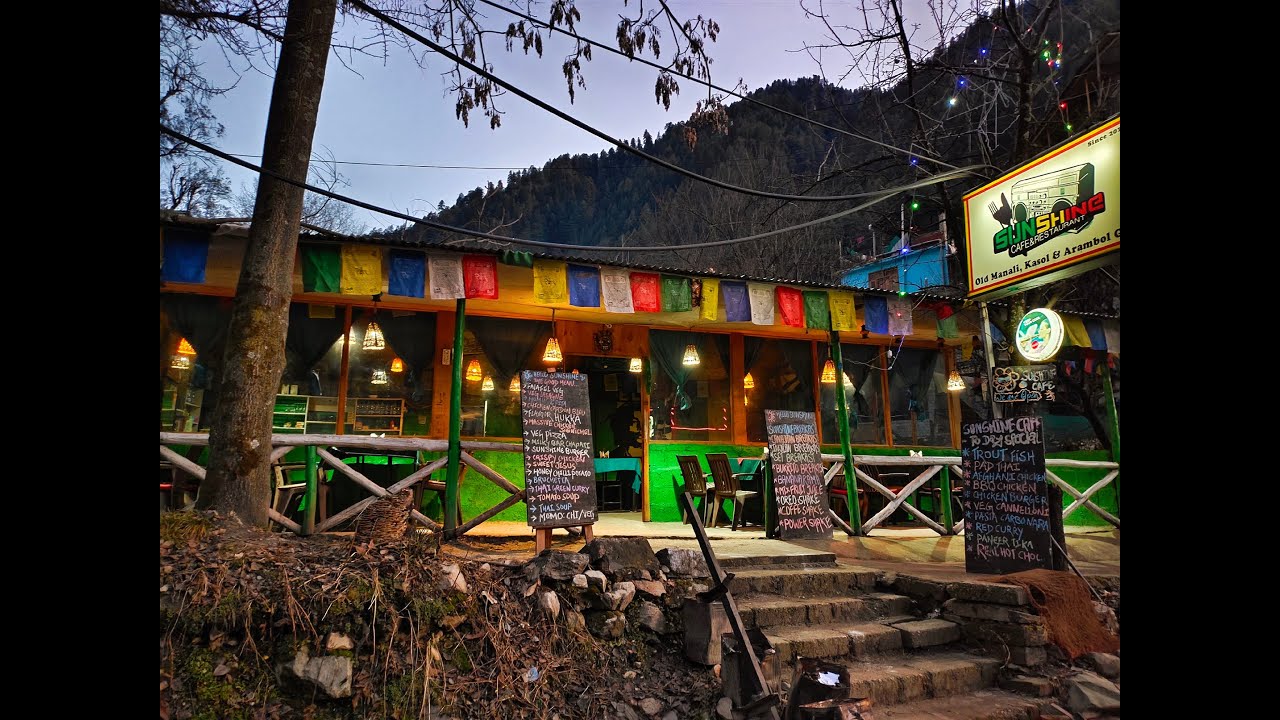Finland’s endless summer days: Island-, lake-, and sauna-hop your way from Helsinki to the Arctic Circle. Dreams of outdoor concerts, kayaking around coastal islands and inlets, picnics and hiking near summer cottages, and sipping cider at sidewalk cafes melt away even the most frosty winter nights in Finland. Even Santa Claus and his reindeer – Rovaniemi in Lapland is their real home, don’t you know – wait for a respite from the sun.
Although somewhat fleeting, Finnish summers are legendary. Temperatures soar to 80 degrees, and the midnight sun bathes the landscape and villages with a gorgeous glow. The summer season begins with Midsummer Weekend, a national holiday celebrated on the longest day of the year. The season ends by September (even earlier in the northern regions), which is why Finns know how to pack in as much fun as possible before it gets dark.
Finland, adjacent to Sweden, Norway, and Russia, is considered by many to be an undiscovered gem. Yes, the northern lights are spectacular and a great winter attraction. But summer is the time to soak up the whole day’s sunshine and breathe the cleanest air in the world. From above, the country looks like an enigma of lakes and lush forests – thanks to a melted ice age glacier – that become a veritable wonderland of outdoor adventure during the warmer months.
The word metsäsuhde refers to the affinity of the Finns for the forest. Briefly translated, it means “a part of a person’s identity and a personal relationship with him that develops through different stages of life.” (Talk about packing a lot in a nutshell!) Finns feel at once with their natural surroundings and happily share their forests with visitors. In fact, by law, everyone can search everywhere, as long as it is done with respect. As the saying goes, tread lightly. From the forests of northern Lapland to the cities of the south, here’s a primer on how to enjoy it.
Helsinki’s Island Life

With dramatic architecture, shop-filled boulevards, and a gorgeous Baltic backdrop, Helsinki is a cosmopolitan haven surrounded by natural beauty. Located on the Gulf of Finland, the city boasts over 300 islands perfect for boating, kayaking, and swimming throughout the summer months.
A favorite pastime is to wander among them through the local ghats. Travelers can visit the Suomenlinna Fortress, a UNESCO World Heritage Site, consisting of six islands. About 30 miles from the city center, take a day trip to quaint towns like Porvoo, where colorful wooden houses line a grid of cobbled streets that date back to the Middle Ages. In summer only fine-dining restaurants such as Sari on the island of Sirpalesari and Sarakanlinna on Sarka are easily accessible by boat for dinner with a view of the bay.
Compact and extremely walkable, Helsinki has a mix of original history, beautiful parks, and sophisticated design and architecture. Summertime brings both food and flea markets. At the end of the day, relax in one of the popular saunas: Allas Sea Pool, Loyly, or Lona.
Water World

Finland earns its nickname, “Land of a Thousand Lakes”, and then some: approximately 188,000 lakes cover a large part of the eastern and central parts of the country. Featuring 18 of 40 national parks, the Lakeland region offers summer visitors long days of relaxing water sports, hiking, bird-watching, summer cottages, saunas, and more. It is no surprise that it was the birthplace of Finnish tourism.
The story goes that the Russian Empress Catherine the Great and her crew were some of the first to visit the Imatrankoski rapids in Imatra, near the Russian border, in 1772. Since then, many people have followed suit. Today, travelers flock to medieval castles (Olavinlinna in Savonlinna), stay in nineteenth-century hotels, or rent thousands of villas or cottages by the lake.
Most of the waterways in the eastern half of the region drain into or out of Lake Saimaa, the country’s largest lake. Cruises on old steamers are a particularly popular way to explore the lake – there is even one that sails from Lappeenranta to Vyborg, Russia (visa-free) – such as wildlife cruises to the endangered freshwater Saimaa. There are ringed seals to behold, of which about 400 exist. Electric-boat trips to the seal habitat depart from Pumala.
Paigean Lake anchors western Lakeland, an area known not only for nature, but also for glassblowing, design, and architecture. About an hour’s drive from Helsinki, the Heim area is a center for glass art, home to the Finnish Glass Museum and the 140-year-old Ittala Glass Factory. About an hour north of the museum, Tampere, Finland’s second-largest city, is known as the “Sauna Capital of the World” with the country’s oldest public sauna and more than 30 experiences. Ask any Finn whose cabins are likely to have private saunas, and they’ll tell you that steaming in the birch-lined huts, followed by a dip in the lake, is the key to health and happiness.
Santa Claus’ Land of the Midnight Sun

While the whole of Finland is considered an Arctic country, Lapland is where the Arctic Circle crosses. Despite having four winter seasons – one of which is called “crusty snow” – the expanse of forest is surprisingly pleasant in summer when the sun never sets (and passes through four airports and three train stations). accessible).
Adventure abounds in Lapland: river rafting and fishing, mountain biking, hiking, and backpacking and glamping – especially from ski resorts like Rovaniemi, Levi, and Luosto. Reindeer overtakes humans throughout the year. It is also home to the Sami, who are the only indigenous people of the European Union.
But perhaps its most famous resident is Old St. Nick. Travelers can visit Rovaniemi’s Santa Claus Village on the Arctic Circle 365 days a year, and meet their tireless toymakers at the Elves’ Hideaway near Levi’s.
Coastal Calling

There are more than 70,000 islands off the coast of Finland. The largest archipelago stretches from Turku into the Gulf of Bothnia and consists of 40,000 small islands and inlets – many connected by bridges and ferries. Visitors can explore this western part of the country, about a two-hour drive from Helsinki, via a 155-mile road trip along the Archipelago Trail, connecting the city of Turku to Åland.
Cycling is particularly popular here as well and is easy to reach with interconnected ferries. Whatever your transportation, plan a few days to take in the area’s beaches, historic lighthouses (some of which are now hotels), and seafood and local cuisine.
The slow tempo of summers suits Finnish sensibilities. The hustle and bustle of Helsinki and the larger cities offer little respite in the warmer months when residents camp out to explore the country. From Lakeland to Lapland and the coastal archipelago, a three-month burst of sunshine makes Finland one of the world’s great adventure-travel playgrounds. Take a page from the local playbook: Get out there, sauna, sleep in, and repeat.
Similar Articles









